Squash – growing seedling from seeds, planting and care
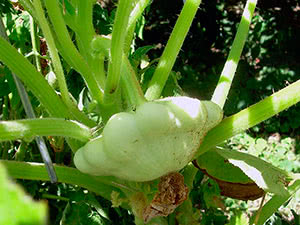 Squash plant, or scalloped squash, is a species of ordinary guard. This herbaceous annual plant is commonly cultivated worldwide and it does not grow in the wild. Originated in North America squash was taken to Europe in XVII century and it became so popular that two centuries later it was grown even in Siberia.
Squash plant, or scalloped squash, is a species of ordinary guard. This herbaceous annual plant is commonly cultivated worldwide and it does not grow in the wild. Originated in North America squash was taken to Europe in XVII century and it became so popular that two centuries later it was grown even in Siberia.
The plant name comes from the Narragansett word “askutasquash” meaning "a green thing eaten raw". Squash plant is recorded in international classification as Cucurbita pepo subsp. ovifera, var. Ovifera.
Description of squash plant
Squash plant is a herbaceous annual plant of semi-bush or bush form with harsh large leaves, solitary unisexual monoecious yellow flowers. Its fruit is either plate-shaped or bell-shaped with stripes and spots depending on the variety. Fruit color can be white, green, yellow, purple or variegated. The value of squash is in its taste qualities and it can be served stewed, fried, pickled or salted. Squash is somehow similar to vegetable marrow, but squash has more delicate flavour that makes it closer to artichoke or asparagus. Squash is a dietary product recommended for diseases of the stomach, liver and kidneys, as well as for atherosclerosis. It is an active diuretic that excretes excess fluid from the body and washes out the salt.
Squash growing from seeds
Squash seed sowing
Squash is propagated by a generative way from seeds that you can buy or extract from a well-ripened fruit. There are two ways to grow squash in the open ground: by seedlings and non-seedlings. But whatever method you choose, before squash planting, you need to prepare seeds. To do this steep them for a day in an aqueous solution of growth stimulants, then rinse thoroughly with water, wrap in wet gauze and hold for two days at a temperature of 68-77 ºF. There is one more way to prepare seeds for sowing: they should be heated at a temperature of 122-140 ºF for 5-6 hours. This measure reduces the risk of squash viral infections that can’t be treated. Good results are achieved by seeds tempering. For this purpose, you should place seeds into tissue pouches and keep them at 64-68 ºF for 6 hours, and then at a temperature of 32-34 ºF for 24 hours. Just before sowing disinfect the squash seeds in a one percent solution of potassium permanganate, then rinse with clean water and dry.
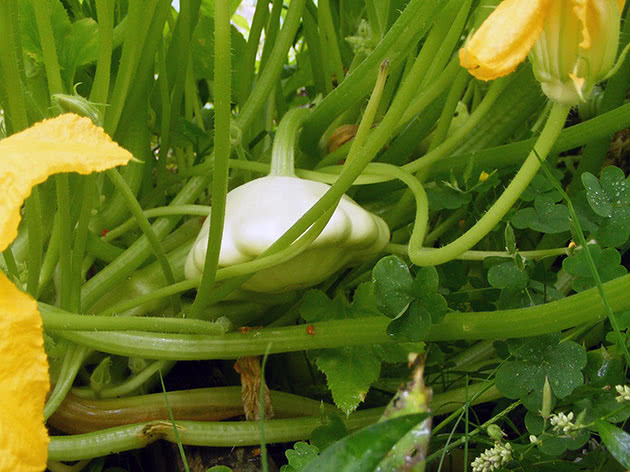
In late May, when soil gets well warmed up and there is no threat of ground frosts, rake the soil at the site, remove weeds, make plant beds and dig patches with the size of 2.3x2.3 ft for the seedlings not to be too closely planted and to prevent squash rot. Seeds are sown at a depth of about 3 inches, several grains in one patch, sprinkled with the ground, carefully watered. Tamp the ground and cover with foil until the shoots appear.
Growing squash seedling
For those who want to get the squash crop as early as possible, there is no choice but to grow squash seedlings. Squash planting for seedlings is carried out in the second or third decade of April by sowing two seeds in disposable cups of 3-4 inches in diameter and to a depth of 1-1½ inches. Soil should be a mixture of humus and forest ground. The seedlings are covered by the foil and are kept at 82-90 ºF, but when seeds germinate, the cover should be taken away and the temperature should get lower to around 77ºF during the day and up to 64 ºF at night. It should be done for the seedlings not to get stretched too much in the growth and save strength for the development of the root system and the cotyledons. In a week, the previous temperature regime can be set up.
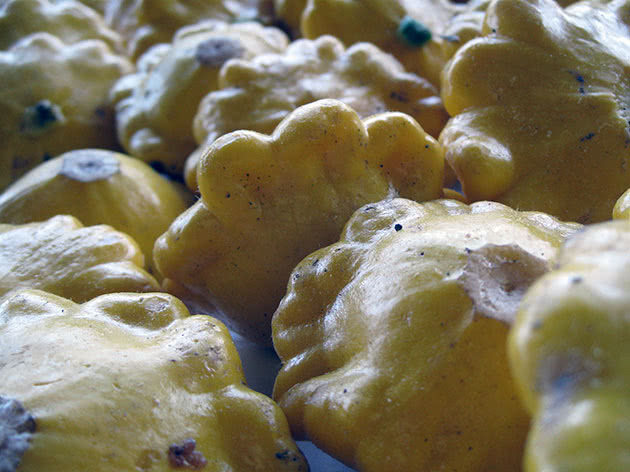
To care for squash seedling you should regularly moisten and fertilize the soil. When the seedlings are 10 days, they are fertilized with 1 part of a solution of mullein and 10 parts of superphosphate infusion. To prepare infusion, pour 0.5 oz of superphosphate with a small amount of water for a day, then add it into mullein solution, without using remained residue. Before planting in the ground, the seedlings are fed once more with 1.7 oz of nitrophosphate solution in 2.2 gallons of water.
Squash pricking-out
You should not prick the squash. When true leaves appear, one of two seedlings that is more robust is left in the cup, and the second one is not pulled out but cut with scissors or a sharp knife just above the ground not to injure the root system of the remaining seedling.
Squash growing in the greenhouse
Squash planting in the greenhouse is carried out at the end of April in disposable cups of 4 inches in diameter at a depth of about 1 inch in loose soil consisting of peat or sod soil, sand or sawdust and humus in the ratio of 5:1:4. Before filling the cups with soil you should fertilize it with a mixture consisting of the following: for one bucket of soil take 0.25 oz of ammonium nitrate, 0.17 oz of potassium sulfide, 0.2 oz of chalk and 0.2 oz of double superphosphate, mix well and pour. Cups with 2-3 seeds are covered with glass or foil and kept at 71-77 ºF at day, and at 62-64 ºF at night. As soon as the shoots appear, the foil is removed, for the first time the shoots are protected from direct sunlight and the maintenance temperature is lowered up to 64-68 ºF at day by airing, and at night the temperature should be at 59-62 ºF. In a week, the previous temperature regime can be set up.

Growing squash seedlings in the greenhouse will require an abundant but infrequent watering with the subsequent obligatory greenhouse airing. Ten days after germination the seedlings are fed with mullein, diluted with water in the ratio of 1:10, with the addition of nitrophosphate at rate of 1.7 oz per 2.2 gallons of water. Before planting in the open ground healthy seedlings should have low stocky stems with short internodes and two or three developed leaves, without counting the cotyledons. When to plant squash seedlings in the plant bed? Squash planting in open ground is carried out in early June.
Squash planting in the ground
When to plant squash in the ground
When home grown seedlings are 3-4 weeks and they have 2-3 true leaves, they are planted in the ground at the end of May or early June. Before this the seedling should get adapted to the fresh air, sunlight and temperature outside. To harden off the seedlings, they are left for several hours in the glazed balcony or unheated terrace with opened window, gradually increasing the time of airing. For the last day or two the window is not closed at all.

Soil for squash
The site for the squash should be protected from wind, sunny, south or southwest, with deep groundwater. The plant loves friable black soil and neutral loam. Acidic soil for squash is not suitable and it must be neutralized by the wood ashes. Squash grows well after such plants as green manure, cabbage, radish, carrot, onion, greens, tomato, peas, potatoes and early vegetables. Undesirable predecessors are vegetable marrows, pumpkins, cucumbers and squash.
Site preparation for squash is carried out in fall: the soil is mixed with rotted manure and mineral fertilizers:
- in the peat soil add 4.4 pounds of organic fertilizers, 1 teaspoon of potassium sulfate and of superphosphate, 2 tablespoons of wood ash per 11 ft² to a depth of 7.8-9.8 inches;
- in the clay soil in autumn add 4.4-6.6 pounds of peat with the addition of humus and sawdust, and a tablespoon of superphosphate and 2 tablespoons of wood ash per 11 ft² at the spade’s depth;
- in the sandy soil per 11 ft² add a bucket of peat and sod land, 6.6 pounds of sawdust and compost and the same squash fertilizer as for the clay soil$
- in the black soil per 11 ft² add 4.4 pounds of sawdust, a tablespoon of powdered superphosphate and 2 tablespoons of wood ash.
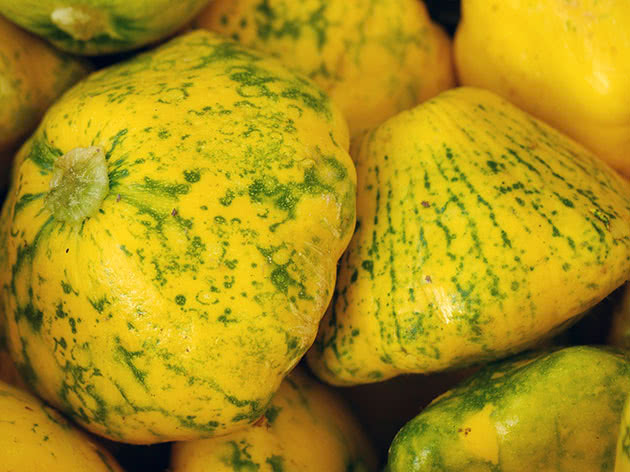
In spring 3-5 days prior to planting, the plant bed is fertilized with a solution of a root growth stimulant, then the plant bed is covered with foil that can be removed only on the day of seedlings planting in the ground.
How to plant the squash in the open ground
The seedlings are planted in the windless cloudy day or in the evening. The planting holes with a depth of not less than 4.7 inches are placed at the same distance as when sowing seeds in the ground – 2.3x2.3 ft, but before planting the holes are watered with a warm water, then the seedlings with a clod of soil are transplanted into planting holes one by one and placed in such way as to make the cotyledonary leaves be at the level of the ground surface, and then add the soil into the planting holes, tamp the soil, mulch the plant bed with peat, and for the first time protect seedlings from direct sunlight.
Care for squash
How to grow squash
Squash growing in the open ground requires regular watering, weeding the plant beds, and adding fertilizers in time. It is easier to weed after rain and watering, when the soil is well moistened. However, you should be very careful while weeding not to harm the superficial root system of squash. Since the plant roots are very close to the surface, the site with the squash is not loosened. Therefore you should not neglect to mulch the plant beds with peat, sawdust, or some other material. If you notice that the squash strongly increases the foliage and does not form the fruit, cut 1-2 old leaves in the morning of a sunny day and repeat this procedure in 4-5 days. Please note that in order to produce fruits squash needs insect pollinators, so when flowering has begun, try to attract bees, wasps and bumblebees by sprinkling the plants with a solution of 3½ oz of sugar per 1¾ pint of water.

Sometimes for some reasons the squashes are not pollinated and require our assistance to carry out artificial pollination. In order to do this pick several male flowers on a long stalk and put them on the female flowers on the short leg. The flowers should not have moisture left after a rain or watering, otherwise pollination will not occur. The more male flowers you will use to pollinate the female flowers, the more seeds will be formed in fruits.
Watering of squashes
How to water squashes? While rooting the seedlings should be watered frequently and abundantly. The squashes especially require watering during fruit formation. Water should be sedimented and warm at 72-77 ºF. Rate of irrigation is 1.3-1.5 gallons per 11 ft² every 5-6 day till flowering. During flowering and formation of ovaries the rate is 1.75-2.2 gallons per 11 ft² every 3-4 days. Water should be poured directly under the root or into deliberately made groove around each plant to keep water from falling on leaves, flowers and ovaries. With such an intense watering the roots of squash quickly become bare, and to protect them during the vegetation period you should add mulch land several times.
When the fruits begin forming, put plates under those fruits that lie on the ground to protect them from rotting caused by the contact with moist soil.
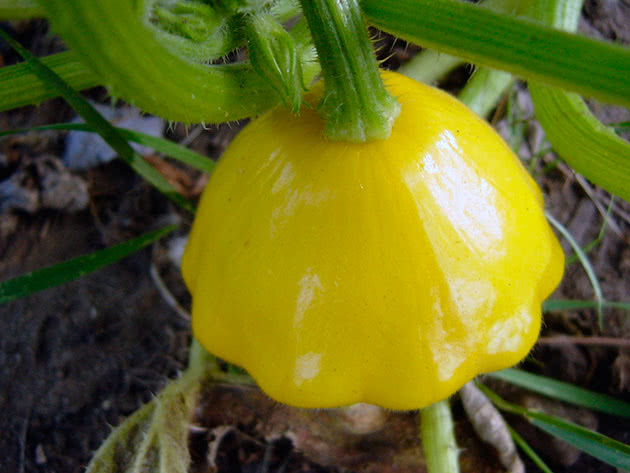
Squash fertilizing
Planted in the ground squashes are fertilized twice. What are the fertilizers for squashes? Before flowering they are fed by 0.5-0.88 oz of double superphosphate, 0.7-1 oz of potassium sulfate and 0.7-1 oz of ammonium sulfate per 11 ft². During ripening per 11 ft² of plant beds add the following fertilizer for squash: dissolve 1.4-1.7 oz of superphosphate and potassium sulfate and 0.7-0.88 oz of ammonium sulfate in 2.2 gallons of water. If you prefer organic fertilization, the best of them is the solutions of mullein (1:10) or of chicken droppings (1:20).
Pests and diseases of squash
What are the diseases of squash? Squash is most likely to be affected by such diseases as anthracnose, ascochyta-leaf spot, white rot, powdery mildew and black mold. All these diseases are fungal. You can get rid of them, if you notice the changes in ground plant parts in time. We recommend you to know the symptoms of these diseases in order to identify them.
Anthracnose is characterized by large watery yellowish spots on the leaves, pink deposit of fungus spores appear on the veins, and then pink sores appear on the stems, fruits, stalks that turn black in autumn. Fungus is particularly active in wet weather.
Ascochyta-leaf spot can be identified by black spots appearing in the nodes of shoots, on the stems and leaves. Subsequently, the affected areas dry up and the plant may die.

White rot can be recognized by light-brown spots on the stems and leaves, eventually turning into deep sores filled with pink slime that also affect squash fruits. High humidity promotes the development of the disease.
Powdery mildew appears as light loose powdered deposit on the upper side of leaves, which causes their premature drying. It affects also the fruits and stems of squash. High humidity is a favourable condition for this disease.
Black mold looks like yellow-brown spots between the veins of leaves, then a dark deposit with spores of the fungus appears. After spots drying, holes are formed on the leaves. Infected fruits cease to grow and shrink.
Such pests as cutworm and melon aphid are dangerous for squashes. Also slugs can harm the plant.
Cutworms lay eggs from which larvae appear. It eats ground parts of the plants and its roots.
Melon aphid affects shoots, flowers, ovaries, the lower side of squash leaves, making them curl and shriveled. High humidity and warm weather promote the development of aphids.
Slugs are more dangerous to the young plants as their leaves can be completely eaten or have large holes.
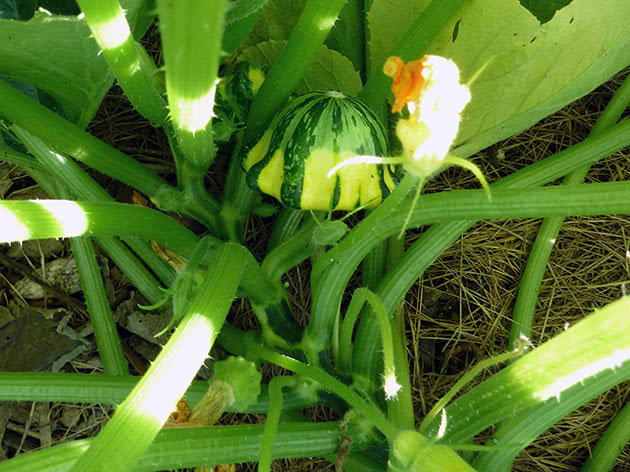
Squash treatment
Fighting with squash pests and diseases can be started when disease or affected areas have already appeared or it can be carried out preventively. Moreover, if you carry out preventive treatment, the disease or affection may not occur at all. What does ‘preventive measure’ mean? Firstly, it implies the compliance with the rules of crop rotation. You should know what plant can be planted after another one. Secondly, it is very important that all agrotechnical practices for the plant are followed. Particularly, you should prevent developing of gelled bushes that increase the humidity in the area and also you should conduct a obligatory pre-sowing treatment of seeds and soil. Thirdly, preventive treatment of plants before flowering is required.
What are the treatment for fungus diseases of squashes? A one per cent Bordeaux mixture and fungicides have the best effect.
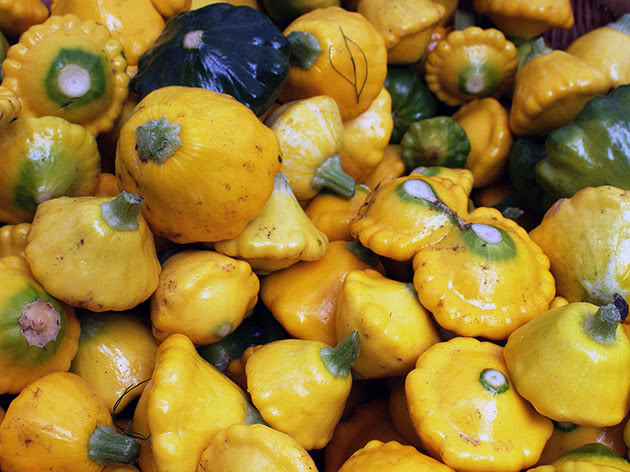
Slugs are hand-picked. Throughout of the site place baits like pieces of melon, pumpkin or watermelon crusts, and when slugs gather for a lunch, they are collected and destroyed. Aphids are killed by treatment of plants with a solution of 10½ oz of soap in 2.2 gallons of water, and to control cutworm larvae you can spray squashes with insecticides. There are other effective means of removing insects and pathogens, but instead of processing squashes with chemicals, you should know that applying crop rotation principals can almost eliminate such problems.
Harvesting and storage of squashes
Squashes are ready to be harvested when they reach technical ripeness: they should have a gentle wax rind with small soft seeds inside. It means that squashes belong to the vegetables that are consumed premature like cucumbers and vegetable marrows. At a state of biological or full maturity squashes have has a thick, rough rind like a ripe pumpkin, and large harsh seeds. It is better to keep such squashes for seeds.
How to collect squashes? Two or three times a week they are cut with the stem, and then they will continue producing fruits until autumn. Do not let fruits overripe as the core of this squash becomes loose and the yield rate is reduced. The last fruit is collected before the frosts and healthy haulm is used for the compost. Squashes are fried and stewed. Small young baby-squashes are marinated and salted as in this way they are even tastier than mature squashes.

Squashes of milky ripeness are stored at 50 ºF not more than 10 days. Squashes with rough rind at a state of biological maturity are stored under the same conditions as vegetable marrow or pumpkin – in a cool, dark, dry place with good ventilation without touching to each other. From time to time you need to inspect the squashes to spot spoiled fruit and to prevent decaying of other fruits.
Species and varieties of squashes
Actually, squashes are the plants for open ground and only their seedlings are grown in the greenhouse. Of course if you have additional space in your greenhouse, you can grow squashes there until they get ripe. However, is there any sense?
Squash varieties for open ground can be shrubs or half-shrubs, early and mid-season. Varieties differ in color of the rind and shape of the fruit. The shape of fruit can resemble a disk, bowl, bell and plate, with wavy, serrated or smooth edges. Usually, the squashes have a white or light green rind, but thanks to the breeders today there are varieties of yellow, orange, purple and dark green squashes.
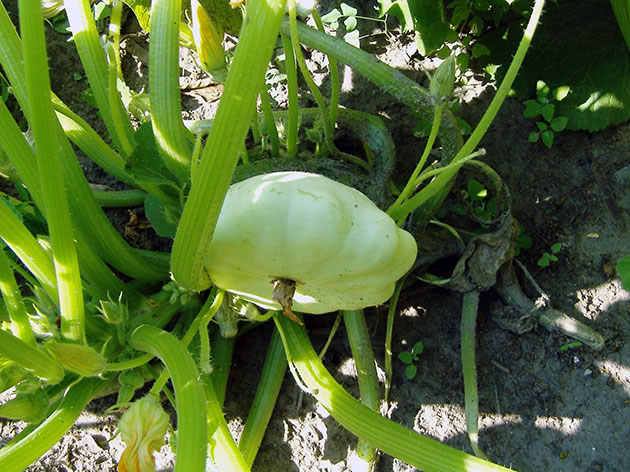
White squashes are represented by the following varieties:
- White 13 is a shrub or half-shrub of middle ripeness with small or medium-sized fruit with slightly serrated edge, pale green or white rind and light yellow rough seeds;
- Disk is an early ripening variety with a thin rind, its fruit weighs 12.3 oz, pulp is savory and not juicy
- Loaf is an early ripening variety that requires special growing conditions with fruits weighing up to 9½ oz;
- Umbrella is a high-yielding early ripening variety with fruits weighing up to 3.3 pounds and in the shape of a cup or a bell;
- Rodeo is an early ripening and high-yielding variety with a small fruits of spicy flavor with a dense but not very juicy pulp;
- Cheburashka is a precocious cold tolerant variety with a thin rind, fruit weights up to 14 oz and has a juicy pulp. It ripens for 35-40 days.

The most popular varieties with yellow and orange rind are:
- Tobolinsky is a shrub of middle ripeness. This variety is resistant to diseases and has smooth orange plate-shaped fruits weighing from 7.7 to 10.5 oz;
- Sunny is a variety of middle ripeness with fruits weighing up to 10.5 oz, pulp is creamy, and young fruits have bright yellow rind, and biologically mature fruits have orange rind;
- Fouette is an early ripening well stored variety with white pulp and sweet taste. Weight of fruit is 8.8-10.5 oz;
- UFO is an early ripening variety that guarantees shoots even under hostile conditions. Its orange fruit is not juicy and weights up to 9.8 oz. The rind is also orange. Pulp contains iron, magnesium, and vitamin C in large amounts.
Pulp contains iron, magnesium, and vitamin C in large amounts:
- Bingo Bongo – the most popular variety with purple rind is Bingo Bongo. It is an early ripening variety with juicy fruits weighing up to 15.8 oz. It ripens in about forty days.
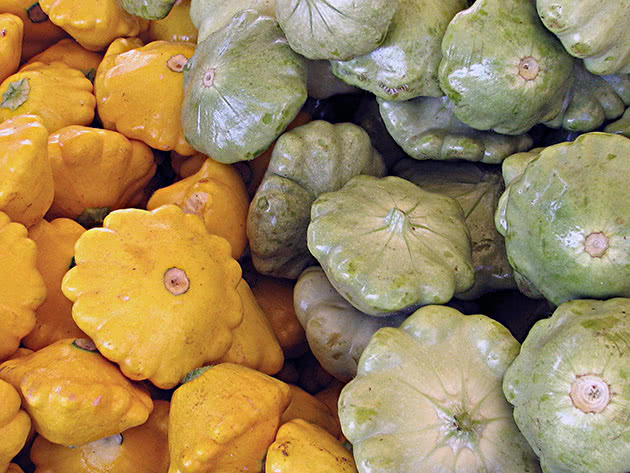
Dark green squashes are:
- Gosha is an early ripening variety with the pulp of cream color and with very dark, almost black rind;
- Chunga-Changa is a middle-ripening variety with dark, tender and juicy fruits weighing up to 24.7 oz.
Additionally, new hybrid varieties of squash should be noted:
- Chartreuse F1 has a dark green, almost black fruit with tender pulp;
- Sunburst F1 is an early ripening compact bush with small bright yellow fruit weighing up to 3.5 oz with a dense creamy pulp and a small amount of seeds.
